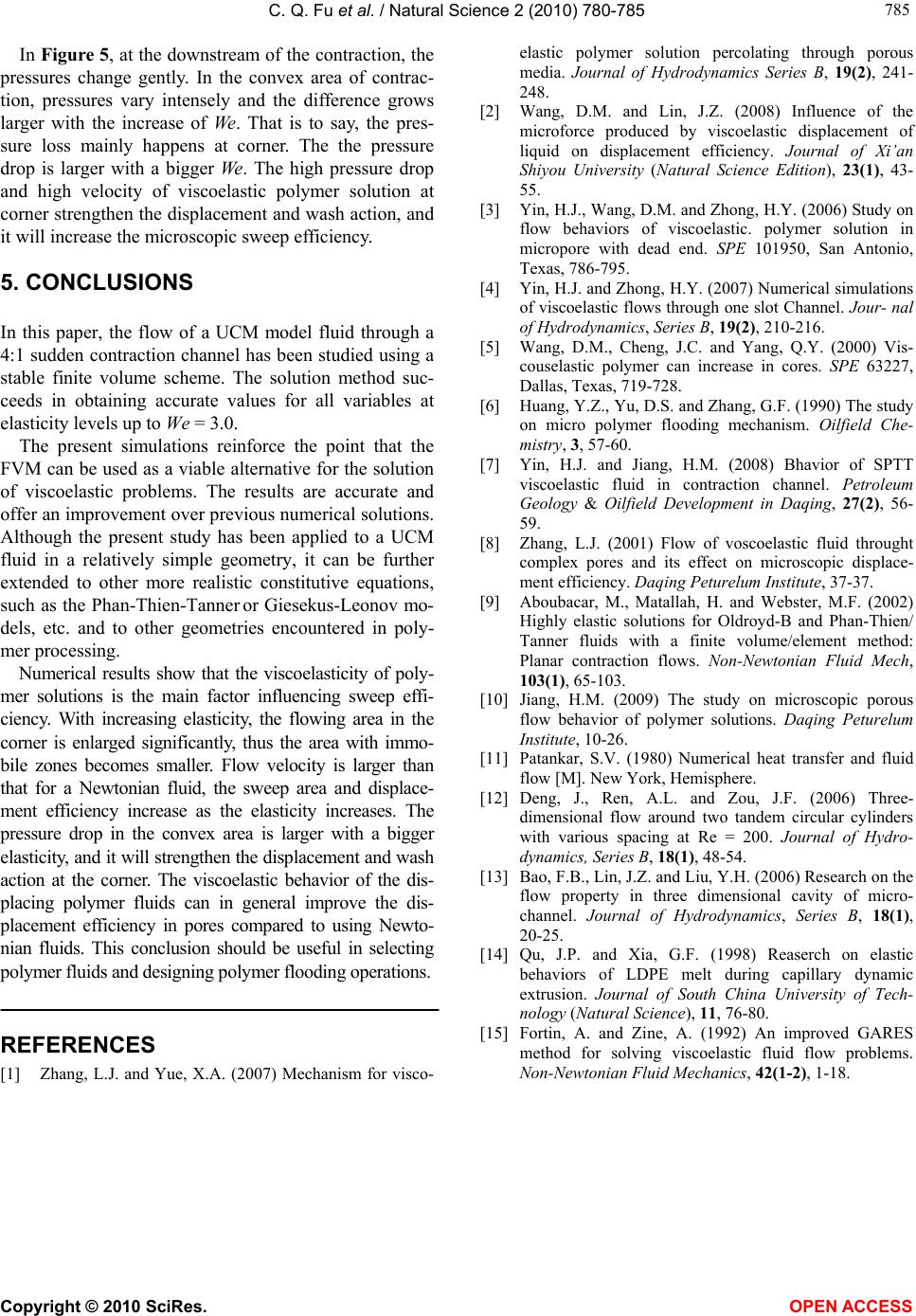
C. Q. Fu et al. / Natural Science 2 (2010) 780-785
Copyright © 2010 SciRes. OPEN ACCESS
785
785
In Figure 5, at the downstream of the contraction, the
pressures change gently. In the convex area of contrac-
tion, pressures vary intensely and the difference grows
larger with the increase of We. That is to say, the pres-
sure loss mainly happens at corner. The the pressure
drop is larger with a bigger We. The high pressure drop
and high velocity of viscoelastic polymer solution at
corner strengthen the displacement and wash action, and
it will increase the microscopic sweep efficiency.
5. CONCLUSIONS
In this paper, the flow of a UCM model fluid through a
4:1 sudden contraction channel has been studied using a
stable finite volume scheme. The solution method suc-
ceeds in obtaining accurate values for all variables at
elasticity levels up to We = 3.0.
The present simulations reinforce the point that the
FVM can be used as a viable alternative for the solution
of viscoelastic problems. The results are accurate and
offer an improvement over previous numerical solutions.
Although the present study has been applied to a UCM
fluid in a relatively simple geometry, it can be further
extended to other more realistic constitutive equations,
such as the Phan-Thien-Tanner or Giesekus-Leonov mo-
dels, etc. and to other geometries encountered in poly-
mer processing.
Numerical results show that the viscoelasticity of poly-
mer solutions is the main factor influencing sweep effi-
ciency. With increasing elasticity, the flowing area in the
corner is enlarged significantly, thus the area with immo-
bile zones becomes smaller. Flow velocity is larger than
that for a Newtonian fluid, the sweep area and displace-
ment efficiency increase as the elasticity increases. The
pressure drop in the convex area is larger with a bigger
elasticity, and it will strengthen the displacement and wash
action at the corner. The viscoelastic behavior of the dis-
placing polymer fluids can in general improve the dis-
placement efficiency in pores compared to using Newto-
nian fluids. This conclusion should be useful in selecting
polymer fluids and designing polymer flooding operations.
REFERENCES
[1] Zhang, L.J. and Yue, X.A. (2007) Mechanism for visco-
elastic polymer solution percolating through porous
media. Journal of Hydrodynamics Series B, 19(2), 241-
248.
[2] Wang, D.M. and Lin, J.Z. (2008) Influence of the
microforce produced by viscoelastic displacement of
liquid on displacement efficiency. Journal of Xi’an
Shiyou University (Natural Science Edition), 23(1), 43-
55.
[3] Yin, H.J., Wang, D.M. and Zhong, H.Y. (2006) Study on
flow behaviors of viscoelastic. polymer solution in
micropore with dead end. SPE 101950, San Antonio,
Texas, 786-795.
[4] Yin, H.J. and Zhong, H.Y. (2007) Numerical simulations
of viscoelastic flows through one slot Channel. Jour- nal
of Hydrodynamics, Series B, 19(2), 210-216.
[5] Wang, D.M., Cheng, J.C. and Yang, Q.Y. (2000) Vis-
couselastic polymer can increase in cores. SPE 63227,
Dallas, Texas, 719-728.
[6] Huang, Y.Z., Yu, D.S. and Zhang, G.F. (1990) The study
on micro polymer flooding mechanism. Oilfield Che-
mistry, 3, 57-60.
[7] Yin, H.J. and Jiang, H.M. (2008) Bhavior of SPTT
viscoelastic fluid in contraction channel. Petroleum
Geology & Oilfield Development in Daqing, 27(2), 56-
59.
[8] Zhang, L.J. (2001) Flow of voscoelastic fluid throught
complex pores and its effect on microscopic displace-
ment efficiency. Daqing Peturelum Institute, 37-37.
[9] Aboubacar, M., Matallah, H. and Webster, M.F. (2002)
Highly elastic solutions for Oldroyd-B and Phan-Thien/
Tanner fluids with a finite volume/element method:
Planar contraction flows. Non-Newtonian Fluid Mech,
103(1), 65-103.
[10] Jiang, H.M. (2009) The study on microscopic porous
flow behavior of polymer solutions. Daqing Peturelum
Institute, 10-26.
[11] Patankar, S.V. (1980) Numerical heat transfer and fluid
flow [M]. New York, Hemisphere.
[12] Deng, J., Ren, A.L. and Zou, J.F. (2006) Three-
dimensional flow around two tandem circular cylinders
with various spacing at Re = 200. Journal of Hydro-
dynamics, Series B, 18(1), 48-54.
[13] Bao, F.B., Lin, J.Z. and Liu, Y.H. (2006) Research on the
flow property in three dimensional cavity of micro-
channel. Journal of Hydrodynamics, Series B, 18(1),
20-25.
[14] Qu, J.P. and Xia, G.F. (1998) Reaserch on elastic
behaviors of LDPE melt during capillary dynamic
extrusion. Journal of South China University of Tech-
nology (Natural Science), 11, 76-80.
[15] Fortin, A. and Zine, A. (1992) An improved GARES
method for solving viscoelastic fluid flow problems.
Non-Newtonian Fluid Mechanics, 42(1-2), 1-18.